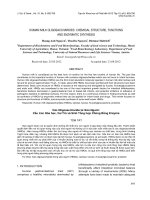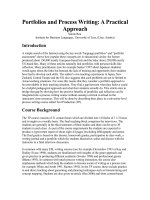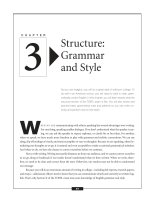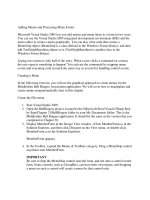Destination managerment: Tourism policy structure content and process
Bạn đang xem bản rút gọn của tài liệu. Xem và tải ngay bản đầy đủ của tài liệu tại đây (5.2 MB, 41 trang )
Destination Management
Tourism Policy Structure
Content and Process
Members of Group 2:
Lê Thị Tuyết Nhung
Nguyễn Thị Linh
Hoàng Thị Minh Ngọc
Nguyễn Thu Trang A
Nguyễn Kim Quyên
Phan Thị Phượng
Tourism Policy:
A Definition
Definition of Tourism Policy
The purpose of tourism policy: to seek to ensure that
visitors are hosted in a way that maximizes the
benefits to stakeholders while minimizing the
negative effects, cost, and impacts associated with
ensuring the success of the destination.
Tourism policy affects the extent to which all the day-
to-day operational activities of toursim, such as
marketing, event development, attraction operations
and visitor recetion programs are successful.
=> It is very important
The focus of Tourism Policy :
The competitive/ Sustainable
Destination
Tourism destinations aredefined in terms by
recognized political jurisdictions:
A nation/country
A macroregion, consisting of several countries/ other
groupings
A province/state within a country
A localized region within a country
A city/town
A unique locale, such as a national park/a historic site
…
The Major Parameters of
Tourism Destination
The competitiveness of a destination refers to its ability to
compete effectively and profitably in the tourism
marketplace.
Successful TDM involves traditional economic/ business
management skills balanced with environmental
management, capabilities
This human presence has two main compenents: visitor
management and resident/community management.
The tasks of resource deployment and resource
stewardship are linked by the shared need for a tourism
destination management information system (TDMIS) to
support policy formulation, strategic planning, day to day
decision, making and overall performance evaluation
1- A model of the competitive/sustainable destination
The purpose of tourism policy is to ensure a common,
agreed upon purpose for tourism and to establish the broad
parameters for planning and coordinating the efforts of all
tourism stakeholders
2- A warning: tourism destination and tourism policy do
not exist in a vacuum
Tourism policies are but part of the social, economic, and
political policies that govern and direct the functioning of
the overall society within which tourism exists and
functions.
A number of more general policies includes:
Passport and visas
Taxation
Interest rate policy
Cultural policy
Education policy
Communications policy
Foreign investment policy /regulations…
To summarize, a whole range of social, economic legal
and technological policies greatly affects the appeal,
attractiveness, competitiveness and sustainability of tourism
destination.
The challenge facing tourism managers is to try to
influence global policies where they can, and adapt to them
as effectively as possible where they cannot
3- The Many Influences on Tourism Policy
Tourism does not exist in a vacuum. It can function
smoothly only if it shares, cooperates and dialogues
effectively with many other sectors of society and of the
economy.
Each of these interfaces can pose either a threat or an
opportunity for tourism. The environment sector and the
extractive industries have traditionally viewed tourism as
a competing force, the technology, entertainment, and
transportation sectors most often perceive tourism as an
ally or business opportunity
4- The Multidisciplinary Nature of Tourism and Tourism
Policy
Tourism is a multidisciplinary phenomenon . the tourism
experience is impacted by a range of economic ,
psychological, societal, technological, legal, and political
forces.
5- Some Other Characteristics of Tourism Policy
In addition to the multidisciplinary nature of tourism
policy, it also possesses several other essential
characteristic:
Tourism Policy
•
Structure
•
Content
•
Process
The Structure of Tourism Policy
While no single model can define the content of tourism
destination policy, Figure 15.5 provides one framework for
tourism policy
Total System and Tourism Macropolicy
Macropolicy, or megapolicy, involves determination of the
premises, assumptions, and main guidelines to be followed
by specific policies
Figure 15.5 The structure and composition of tourism policy
Tourism Vision
Tourism Objectives and
constraints
Tourism Philosophy
Macromanagement
Organizational
Structure
Supply
Development
Strategies
Demand
Development
Strategies
Operational/Tatical
Supply Development
Policies/Programs
Operational/Tatical
Demand
Development
Policies/Programs
DESTINATION SOCIOECONOMIC MACRO-LEVEL
POLICIES
-
Providing the more functional and more inspirational portrait
of the ideal future
-
Visions can take many different forms. Typically, a destination
vision is structured as shown in Figure 15.6 .
Destination Vision
- A Conceptual Frameword -
PreamblePreambleCore VisionCore Vision
Elements of the VisionElements of the Vision
VALUEVALUEPRINCIPLESPRINCIPLES









